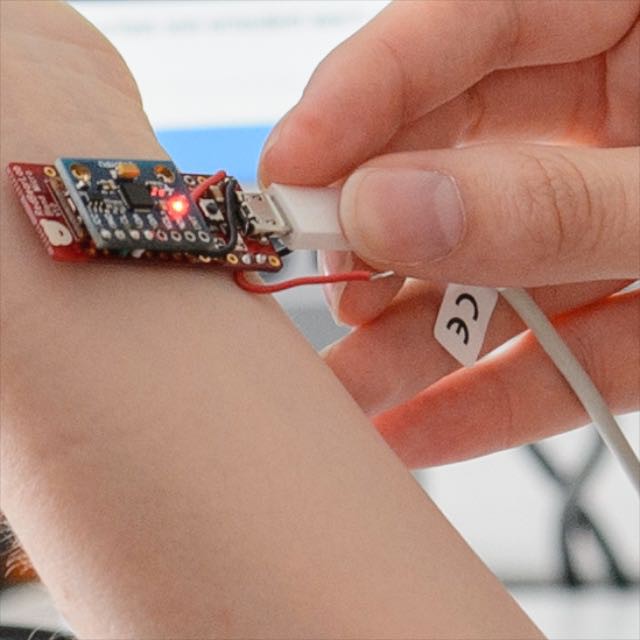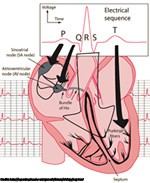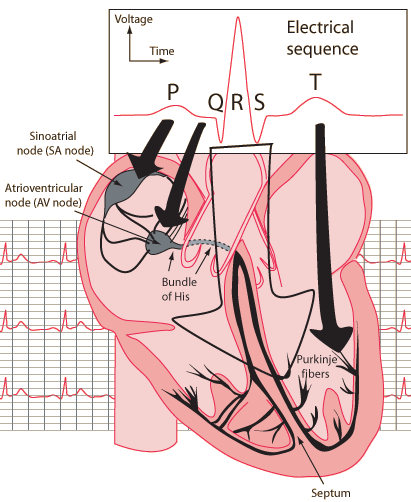Many definitions for sleep, like the one given by The Columbia electronic encyclopaedia, characterize sleep as being a “resting state in which an individual becomes relatively quiescent and unaware of the environment. During sleep, which is in part a period of rest and relaxation, most physiological functions such as body temperature, blood pressure, and rate of breathing and heartbeat decrease. However, sleep is also a time of repair and growth, and some tissues, e.g., epithelium, proliferate more rapidly during sleep."
Although the phenomenon is not completely understood by scientists, it is clear from the EEG measurements that it can be divided into NREM and REM stages.
In REM sleep, the main feature is muscle paralysis which blocks the neuronal connection between the brain and most muscles. Muscle paralysis prevents the awake-like brain activity from causing movement of the body during sleep. It is also during this stage that the brain is more active and dreaming is more frequent and vivid, although dreaming does occur also during NREM sleep [1].
In 1968, Rechtschaffen and Kales based on EEG changes, divided NREM sleep into four further stages: N1, N2, N3, N4. In 2007 was published, the AASM Manual for the Scoring of Sleep and Associated Events resulting in some changes, with the most significant being the combining of stages N3 and N4 into one stage N3.The stage N1 represents the drowsy state between wake-fullness and sleep, and the depth of sleep is progressively increased in stages N2 and N3 [2].
To better visualize these general patterns, researchers use a type of graph called a hypnogram. A hypnogram is nothing more than a minute-by-minute graphic record of a night’s sleep, as captured by an EEG. The hypnogram thus shows not only the sequence in which the various stages of sleep occur, but also the times at which each stage starts and ends.
By analyzing a typical hypnogram such as the one shown in Figure 1.1, we see that a few minutes after falling asleep, we slip deeper and deeper into non-REM sleep: first into light non-REM sleep (stages 1 and 2), and then into deep non-REM sleep (stages 3 and 4).

Figure 1.1: An exemplary hypnogram of a healthy young adult [3]
Another striking feature of the hypnogram is the recurrent cycles in which the various stages of sleep follow one another, somewhat like a series of waves: 1-2-3-4-3-2-1-REM-1-2-3-4-3-2-1-REM, etc. Thus each descent into deep non-REM sleep is followed by a climb back up directly into a period of REM (or paradoxical) sleep. [3]

Figure 1.2: The “train” of a night of sleep comprises many “cars” that are linked to one another in a specific order to form 4 or 5 major cycles [3]
NREM and REM sleep are known to alternate in cycles, each lasting approximately 90–110 minutes (min) in adults, with approximately 4–6 cycles during the course of a normal 6–8 hour (h) sleep period. However, these timings change depending on the length of time asleep, age, medication, physical health and mental health. Furthermore, brief micro-arousals can occur, lasting (by definition) from 1.5–3 seconds (s) and short awakenings (defined to be longer 15 s). [4]
The Table 1.1 shows a summary of how the effects of the different stages can be seen in heart rate, respiration, temperature and movement activity. The middle column shows how sleep stages affect movement, heart rate, respiration and the electrophysiological features of sleep stages, listed in column one [5].
| Sleep Stages |
Effects |
Features |
| Wakefulness |
Much movement
Stable respiration |
EEG: Alpha activity(8-13 Hz) for >= 50% of the epoch |
| NREM N1 |
Little movement
Decreased HRV
Instability in respiration amplitude |
EEG: Alpha activity for < 50% of the epoch
Low-voltage mixed-frequency activityVertex sharp waves
EOG: Slow eye movements |
| NREM N2 |
Little movement.Decreased HRVStable respirationBody temperature decreases |
EEG: Slow-wave activity (0.5-2 Hz) for <20% of the epochSleep spindles or K-complexes |
| NREM N3 |
Little movementDecreased HRVVery stable respiration |
EEG: Slow-wave activity for >= 20% of the epoch |
| REM |
Movements during phase REMIncreased HRV and blood pressureUnstable respirationFluctuations in body temperature |
EEG: Low-voltage mixed-frequency activitySaw-tooth waves (2-6 Hz)EMG: Low activityEOG: Rapid eye movements |
Table 1.1: The different effect of each sleep stage on vital signals
Sleep disorders are changes in sleeping patterns or habits. Signs and symptoms of sleep disorders include excessive daytime sleepiness, irregular breathing or increased movement during sleep, difficulty sleeping, and abnormal sleep behaviours. A sleep disorder can affect one’s overall health, safety and quality of life.
According to AASM [6], there are over 80 known sleep disorders and they can be classified into seven categories, each with the characteristics described below. Additionally there is the 8th group called "isolated symptoms, apparent normal variants and unresolved issues".
Insomnias
Difficulty initiating or maintaining sleep, early awakening or poor sleep quality characterize this category. It frequently coexists with medical, psychiatric, sleep, or neurological disorders and is characterised by a reduction of total sleep time and latency for REM sleep, an increase in spontaneous micro-arousals, a reduction of slow-wave sleep and an increase in rapid eye movements [7].
Sleep-related breathing disorders
Symptoms for this category include: abnormal respiration during sleep, chronic snoring, upper airway resistance syndrome, apneas and obesity hyperventilation syndrome. When an apnea occurs, sleep usually is disrupted due to inadequate breathing and poor oxygen levels in the blood. Sometimes the person wakes up completely, but sometimes the person comes out of a deep level of sleep and into a more shallow level of sleep. A hypopnea is a decrease in breathing that is not as severe as an apnea. The apnea-hypopnea index (AHI) is an index of severity that combines apneas and hypopneas [8].
Central sleep apnea (CSA) occurs when the brain does not send the signal to the muscles to take a breath and there is no muscular effort to take a breath.
Obstructive sleep apnea (OSA) occurs when the brain sends the signal to the muscles and the muscles make an effort to take a breath, but they are unsuccessful because the airway becomes obstructed and prevents an adequate flow of air.
Mixed sleep apnea, occurs when there is both central sleep apnea and obstructive sleep apnea.
Hypersomnias of central origin
This is a separate category for hypersomnias of central origins which are not due to circadian rhythm sleep disorders, sleep related breathing disorders or other cause of disturbed nocturnal sleep. It includes only those disorders in which the primary complaint is daytime sleepiness and abnormal REM sleep. Narcolepsy is the most common disorder in this group. [6]
Circadian rhythm sleep disorder
These are disruptions of the circadian time-keeping system that regulates the (approximately) 24h cycle of biological processes. The circadian pacemaker in humans is located mainly in the suprachiasmatic nucleus, which is a group of cells located in the hypothalamus. Circadian rhythms affect sleep and wake cycles, cortisol release, body temperature, melatonin levels, and other physiologic variables and can be (non-pathologically) disturbed by shift work, time zone changes (jet-lag), medications and changes in routine.
Parasomnias
Parasomnias are disorders that intrude into the sleep process and are manifestations of central nervous system activation producing nonvolitional motor, emotional, or autonomic activity. Most parasomnias are associated with a specific type of sleep (rapid eye movement [REM] or non-rapid eye movement [NREM] sleep). [6]
Parasomnias usually associated with REM sleep include nightmares and sleep paralysis and the ones associated with NREM sleep are night terrors, enuresis nocturnal, bruxism, sleepwalking and confusional arousals. [6]
Sleep-related movement disorders
Sleep related movement disorders are characterized by simple, stereotypic movements that disturb sleep. Movements that occur during sleep but do not adversely affect sleep or daytime function are not considered a sleep related movement disorder. Classic sleep related movement disorders include restless legs syndrome, periodic limb movement disorder, sleep related leg cramps, sleep related bruxism(teeth grinding), and sleep related rhythmic movement disorder. The most common is the Restless Leg Syndrome which is a neurological disorder and causes an irresistible urge to move the legs to relieve an uncomfortable sensation deep within the legs during non-REM sleep. [9]
Other sleep disorders
In this group alcohol abuse-related or psychiatric disorders are listed.
References
| [1] |
T. Hori, Y. Sugita, E. Koga, S. Shirakawa, K. Inoue, S. Uchida, H. Kuwahara, M. Kousaka, T. Kobayashi, Y. Tsuji, M. Terashima, K. Fukuda and N. Fukuda, "Proposed supplements and amendments to ’A Manual of Standardized Terminology, Techniques and Scoring System for Sleep Stages of Human Subjects’, the Rechtschaffen & Kales (1968) standard", 2001.
|
| [2] |
C. Iber, S. Ancoli-Israel, A. Chesson and S. F. Quan, "The AASM manual for the scoring of sleep and associated events: rules, terminology and technical specifications", 2007. |
| [3] |
"The brain from top to bottom," [Online]. Available: http://thebrain.mcgill.ca/. Retrieved on 2014.
|
| [4] |
S. Martin, H. Engleman, R. Kingshott and N. Douglas, "Microarousals in patients with sleep apnoea/hypopnoea syndrome", 1997. |
| [5] |
P. R. G. Ribeiro, "Sensor based sleep patterns and nocturnal activity analysis," 2014. |
| [6] |
American Academy of Sleep Medicine, "The international classification of sleep disorders," 2005. |
| [7] |
S. Maria, G. Pereira and A. Smith, "Diagnostics methods for sleep disorders," 2005. |
| [8] |
"MedicineNet," [Online]. Available: http://www.medicinenet.com/. Retrieved on 2014.
|
| [9] |
L. a. Panossian and A. Y. Avidan, "Review of sleep disorders", 2009. |





















